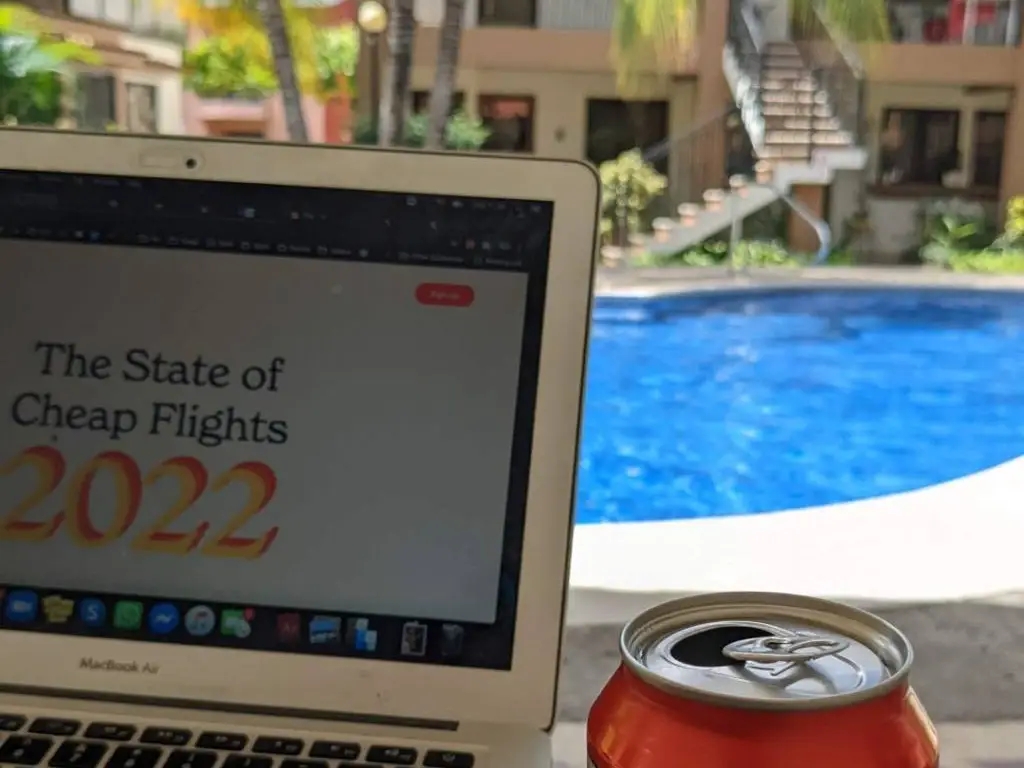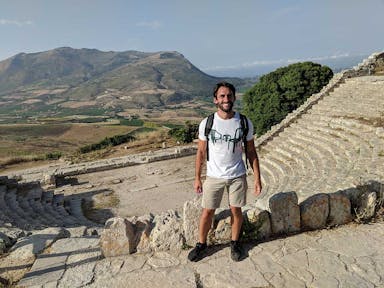
The Expert Guide to Combining Work and Travel
Going is, and has always been, an all-remote workplace, with over 50 travel-loving employees who are always itching to get out and explore the world.
In my three years here, I’ve sent emails from floating villages on Lake Titicaca, done Zoom calls from trains in rural Sicily, and been on live TV from a tiny town on a dirt road in Costa Rica. I’ve gotten pretty dang good at packing up my laptop (And my dog. And my baby) and hitting the road for a few weeks, or months, at a time, and I’ve also picked up some pointers from my coworkers along the way.
If you’re someone who’s got a remote work arrangement and are ready to work from an exotic locale but are not quite sure how to get started, read on, friend, we’ve got you.
The world is your oyster—here’s how to pick your pearl
You’ve got the clearance to work remotely, now it’s time to pick a destination. My biggest advice here is to follow your heart (and the deals).
The main things to consider are:
- The local cost of living & renting a work-friendly place to stay
- Time zone (more on that below)
- Visas (how long can you stay before getting the boot? Do you need to apply for a visa?)
- Your personal WFH travel approach (we’ll start here)

Your WFH traveler approach
While there are countless ways to combine travel and remote work, I have two preferred approaches: Live Like a Local, or Tasting Menu.
The Live Like a Local approach is the one I take the most often. This means settling into one city or town for a stretch of a month or more, really getting to know the neighborhood and the locals, shopping at local markets, chatting with neighbors, and soaking up the vibes.
When I travel this way, I scatter my time off, taking several 3 or 4-day weekends for side trips. In Naples, I spent my weekdays enjoying my neighborhood, eating pizza, and working, and my weekends in the Amalfi Coast or hopping quick, cheap flights to places like Sardinia. Not bad.
For those of us who dream of living abroad, this approach is great for testing the waters, and affords an opportunity for longer-term activities like language classes or volunteer work. Another distinct advantage is cost. Many accommodations on booking sites like Airbnb offer discounts for longer stays. I’ve often found stays of 28 days to be only slightly more expensive than stays of 10 or 12 days, for example.
If you opt to take this approach, try to resist the temptation to settle down right smack-dab in the center of your bucket list destination city without considering alternatives. While nobody can deny the allure of the Eiffel Tower or Florence’s Duomo, living for weeks at a time among throngs of tourists is bound to be exhausting (not to mention expensive), and you won’t get as much out of your trip as you would if you choose a neighborhood just outside of the city center, or a nearby, lesser-known city. Don’t worry, you’re spending plenty of time in your destination country, you’ll have ample opportunity to snap that perfect selfie.
If you’re more excited about sight seeing or excursions than local vibes, the Tasting Menu approach might be more your speed. This entails mapping out several easy-to-connect destinations and spending a week or so in each of them, getting a nice little taste of everywhere while splitting time between work and play. In this case, with less time in each destination, it could make more sense to choose more centrally-located accommodations, allowing you to take full advantage of your more limited non-working hours.
Like the previous approach, I find the best way to maximize your time is to take several long weekends. In Peru, I spent my work days in modern coffee shops with killer views and my long weekends hiking Colca Canyon, on a boat in Lake Titicaca, or exploring the Sacred Valley.
If you take this approach, it’s important to map out your route from one locale to another ahead of time so you don’t waste a precious weekend or PTO day in transit for 10 hours. This approach works best in countries where domestic flights are cheap, frequent, and efficient (like Peru, Colombia, Chile, Mexico, and much of Europe and Southeast Asia), or where high speed trains can get you from destination to destination quickly.
Considerations for your remote workspace

In The Before Times™, I loved to bunk up in a hostel or squeeze into a tiny room in a stranger’s home. But for long hours at the computer and/or frequent video calls, you need adequate, comfortable, quiet space. Luckily, most accommodation booking sites now include a “Dedicated Workspace” filter in their search options, and more budget accommodations are adding coworking space to their list of amenities, though browsing through a listing’s photos can oftentimes be just as helpful.
Are you comfortable working at a kitchen table, or do you need a desk? Are you okay having your bed in the background of your Zoom calls? And almost as importantly (for me, at least), does the work area remind you that you’re away from home? There is something so gratifying about working with toucans scooting by in the background in Costa Rica, or with a view of the Leaning Tower of Pisa.
A second consideration is internet speed. Don’t simply assume that because an apartment is in a nice neighborhood of a wealthy city the internet will be great, or that rural accommodations will run on dial-up. Read reviews of potential accommodations carefully, looking for recent mentions of internet speed. If you’re unsure, reach out to the host and ask for a screenshot of a speedtest—if they’re not willing to do so, take that as a red flag. You’d also be wise to do a little research around the costs of mobile data and hotspots in your chosen country. For example, I’ve found that in Italy, mobile data is so cheap and reliable that I can simply drop $25 USD per month on a local phone plan and work off my hotspot without any issues.
Time travel: pros, cons, and considerations
For some jobs, working hours are working hours, with no excuses. Luckily for these folks, the Western Hemisphere is big, and there’s a heck of a lot to explore. Oaxaca. Cartagena. Buenos Aires. Montego Bay. You’ve got options.
And for you Europhiles out there, I’ve got good news: as long as you don’t mind staying up a little late, working East Coast US hours from Europe can be an absolute delight. In Europe, I spend my mornings wandering the streets of my chosen homebase, have a big lunch out, and then start work in the late afternoon, using a ‘lunch break’ to sneak out for dinner, a walk, or a drink. It makes for long, but extremely fulfilling days.
If you plan to go further afield, namely, Asia/Oceania, make sure you’re either (a) able to work during local daylight hours, or (b) comfortable with working an overnight shift. The last thing you want is for your working hours to prohibit you from having enough energy to enjoy Bangkok, Auckland, or Tokyo. If your online hours are flexible, however, working in a far-off time zone means you can be online all by yourself while your coworkers are sleeping, so you can engage in deep work without any interruptions. I’ve talked to several people who have had the same experience, feeling strangely more productive when working odd hours abroad.
Bottom line. The pandemic has been objectively awful, but the increase in remote work that it has led to has created a golden opportunity for folks to really get out and spend more time traveling. If you have the option to do so, we say go for it. After all, you miss 100% of the shots you don’t take.
Published August 7, 2023
Last updated February 21, 2024
Treat your travel to cheap flights
Most deals are 40-90% off normal prices with great itineraries from the best airlines. If it's not an amazing deal, we won't send it. Sign up for free to start getting flight alerts.




